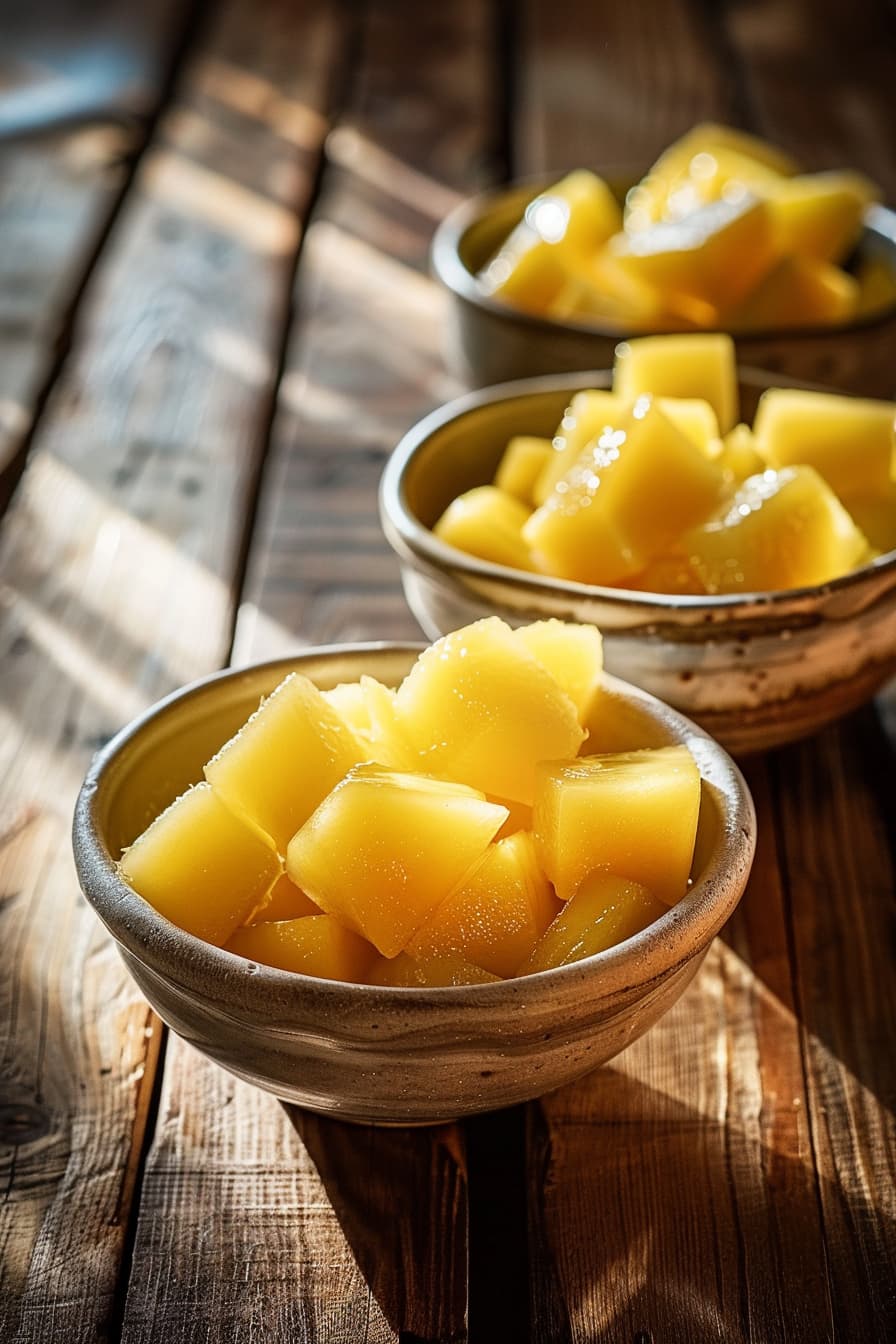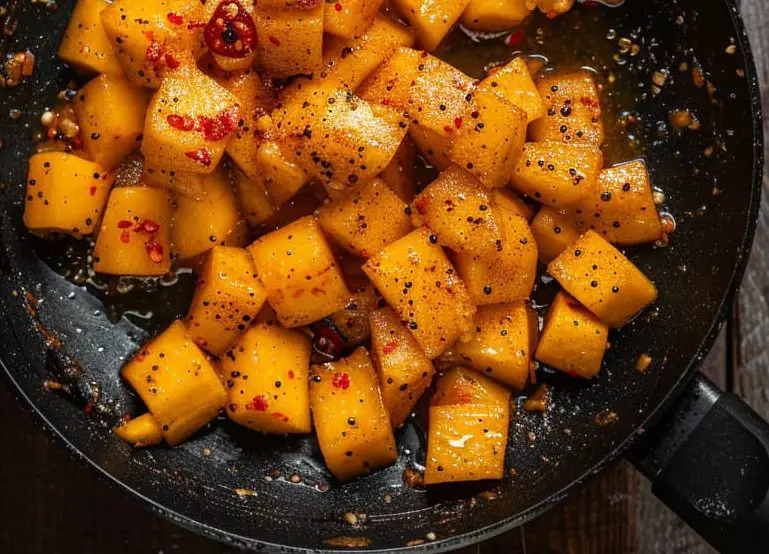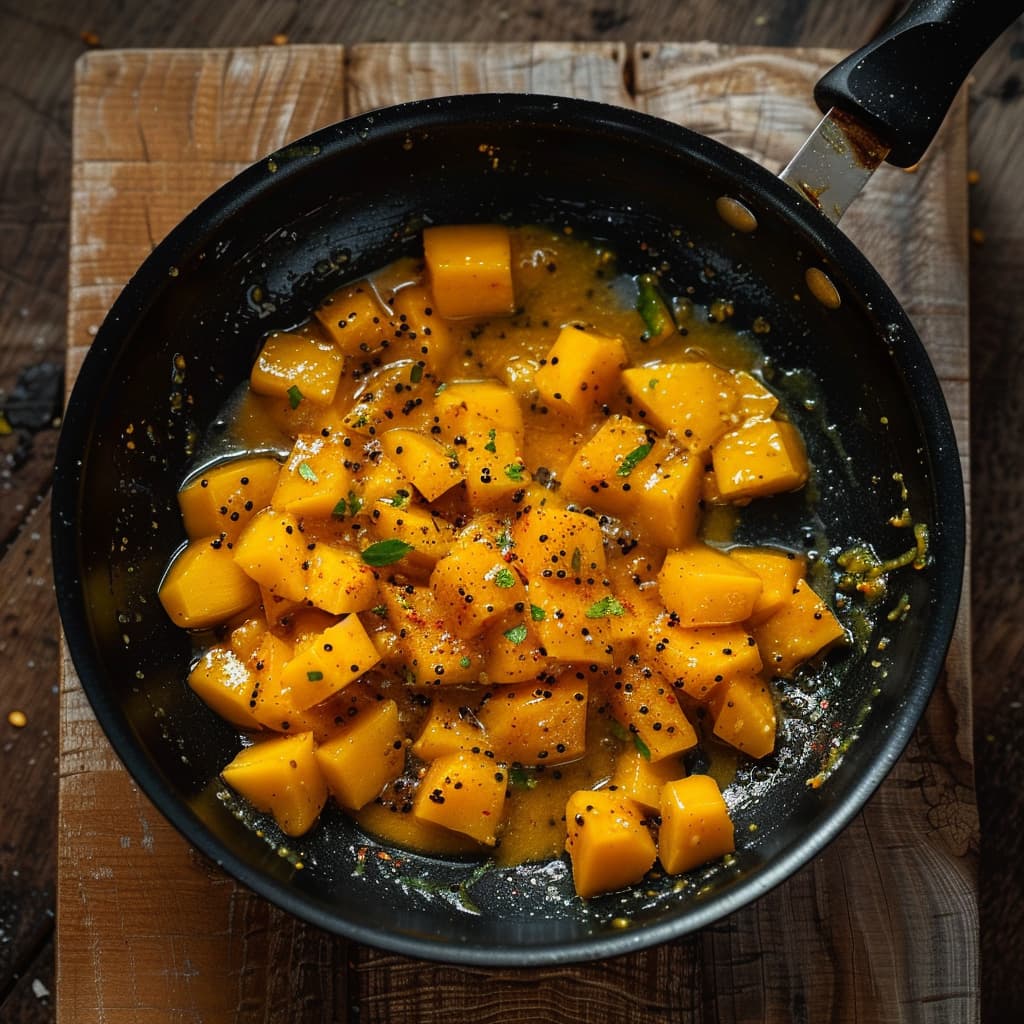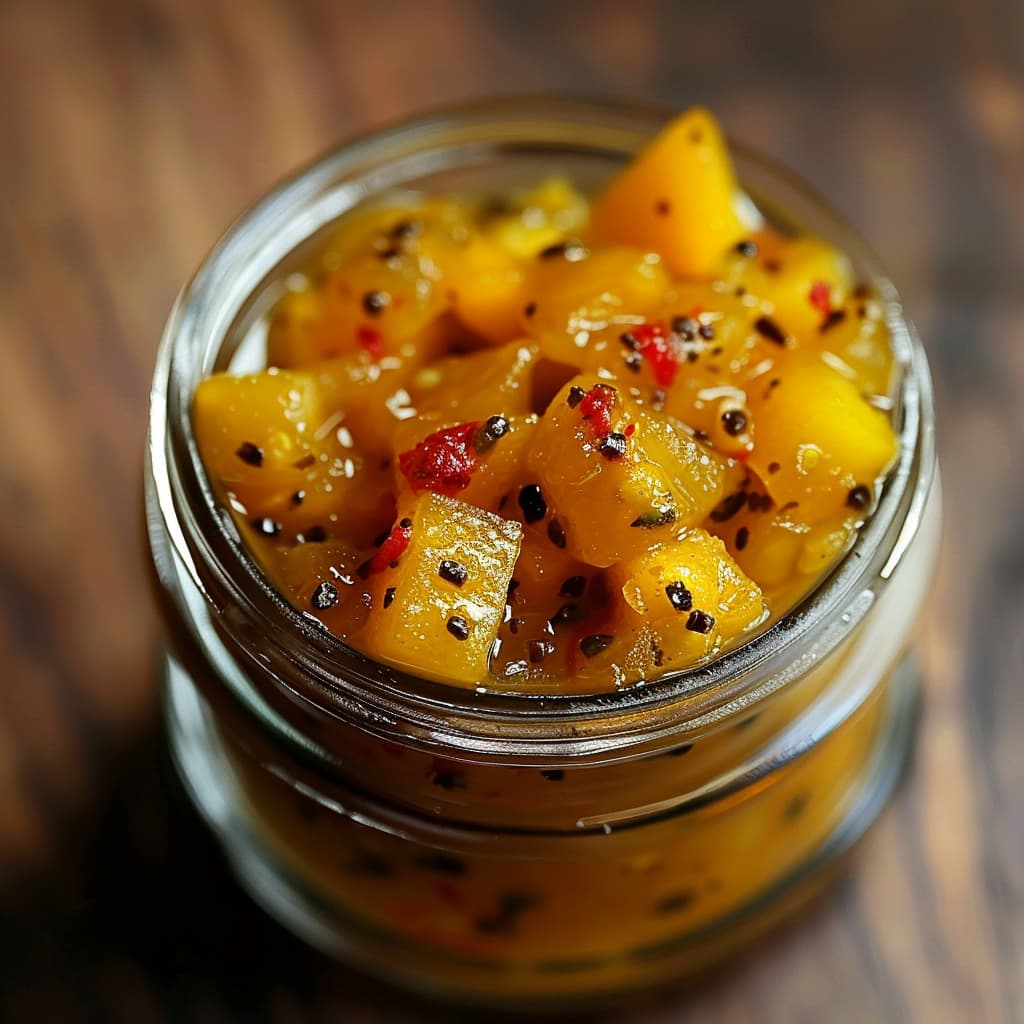Spiced Mango Chutney Recipe

Indian Spiced Mango Chutney is a celebrated Indian recipe cherished across the globe for its tangy sweetness and spicy kick. Did you know this versatile condiment dates back centuries in Indian cuisine, serving as a delicious bridge between past and present culinary traditions?
In just 30 minutes, and with simple, vibrant ingredients, you can create an authentic Indian masterpiece right in your kitchen.
Why You’ll Love This Recipe:
- Versatile Use: Pair it with curries, rice, bread, sandwiches, or even as a unique glaze for meats.
- Quick and Easy: Ready in 30 minutes, it’s a simple way to add Indian flavors to your meals.
- Health Benefits: Mangoes are rich in vitamins A and C, adding a nutritious boost to your diet.
- Make-Ahead Magic: This chutney keeps well, allowing you to enjoy a touch of summer any time of the year.
In this guide, you’ll learn
- Some Interesting Facts and Origin Story of Spiced Mango Chutney
- How to make mouth-watering Spiced Mango Chutney in your kitchen
- Common Mistakes To Avoid, Pro Tips To Enhance The Taste Of the Dish
- FAQs (Reader Questions Answered) and much more stuff!
So, grab your apron, and let’s dive in!
Some Interesting Facts About Mint Chutney
Spiced Mango Chutney, with its roots deeply embedded in Indian cuisine, is believed to have originated thousands of years ago.
- The term “Chutney” in Hindi translates to “to lick,” highlighting the dish’s irresistible nature.
- While traditionally made with ripe mangoes, sugar, and vinegar, Indian Spiced Mango Chutney welcomes variations. You can easily adapt it to include additional fruits like peaches or apples or introduce nuts for added texture, making it a perfect fit for different dietary preferences or meal times.
The practice of chutney-making started as a method to preserve food. Mangoes, being abundant in India, were a natural choice for creating a sweet and spicy condiment. The traditional recipe involves simmering mangoes with sugar and a variety of spices, a method that has been passed down through generations.
- Mango chutney, in particular, is a symbol of the summer season and is often made in large batches to be enjoyed throughout the year.
- It holds a place in daily meals as well as in festivities and religious ceremonies, showcasing the versatility and richness of Indian culinary traditions.
While the basic ingredients of mango, sugar, and spices remain constant, regional variations of Spiced Mango Chutney abound across India.
- In the South, it might be prepared with curry leaves and mustard seeds, adding a unique flavor.
- In the North, it often includes fennel and nigella seeds, giving it a distinctive taste.
- Eastern India prefers a sweeter version, sometimes incorporating dates and raisins. Each region adds its local flavors and ingredients, making the chutney a reflection of India’s diverse culinary landscape.
How to Make Spiced Mango Chutney Recipe At Home As A Beginner
Preparation Time: 15 minutes
Cooking Time: 30 minutes
Total Time: 45 minutes
Serves: 4
Ingredients:
- Ripe mangoes: 2 large, peeled and finely diced (about 3 cups)
- Sugar: ½ cup (100g) [or honey (for a natural sweetener)]
- Apple cider vinegar: ⅓ cup (80ml) [or white vinegar]
- Garlic: 1 clove, minced
- Ginger: 3 cm piece, grated
- Red chili flakes: ½ teaspoon (adjust to taste) [or a small, finely chopped fresh chili for a fresher spice]
- Cumin seeds: 1 teaspoon
- Mustard seeds: ½ teaspoon
- Turmeric powder: ½ teaspoon
- Salt: ½ teaspoon
- Raisins: ¼ cup (optional for added sweetness and texture)
- Water: ¼ cup (if needed for consistency)
- Oil
Instructions:
Prepare the Mangoes:
Start by peeling and finely dicing the mangoes. You want small pieces to ensure the chutney has a nice, spreadable consistency.
For the best flavor, use mangoes that are ripe but still firm. Overripe mangoes might make the chutney too mushy.

The sweetness of mangoes can vary significantly. Taste your mangoes before adding sugar or honey to the chutney. Start with less sweetener, and adjust based on the natural sweetness of the fruit and your personal preference.
Cook the Spices:
In a medium-sized, heavy-bottomed pan, dry roast the cumin and mustard seeds or fennel seeds over low heat until they start to pop. This releases their aromatic oils, enhancing the chutney’s flavor.
![dry roasting [1 teaspoon cumin seeds] and [1/2 teaspoon fennel seeds] in a pan](https://tastycookingaroma.com/wp-content/uploads/2024/04/almostawake21_dry_roasting_1_teaspoon_cumin_seeds_and_12_teas_4c1780be-be8c-4a72-8512-b111b1d7f249_3-e1712343414488.jpg)
Sauté the Aromatics:
Add a splash of oil to the pan, then sauté the minced garlic and grated ginger until fragrant, about 1 minute.
![oil with minced garlic and grated ginger and [1 teaspoon cumin seeds] and [1/2 teaspoon fennel seeds]](https://tastycookingaroma.com/wp-content/uploads/2024/04/almostawake21_oil_with_minced_garlic_and_grated_ginger_and_1__be7c560d-36c8-42ce-b170-ed97d8f24598_3-e1712377215340.jpg)
Be careful not to burn them; the goal is to soften the raw edge and infuse the oil.
Simmer the Mangoes:
Add the diced mangoes to the pan, stirring to coat them with the spices. Add the sugar (or honey), apple cider vinegar, chili flakes, turmeric, and salt. Mix well.

Adjusting Sweetness and Spice:
Taste as you go and adjust the sugar/honey and chili according to your preference. The beauty of chutney lies in finding the perfect balance for your palate.
Let It Cook:
Allow the mixture to come to a gentle boil, then reduce the heat and let it simmer uncovered. Stir occasionally, and if the mixture seems too thick or starts sticking to the bottom, add a little water.

Add Raisins:
If using, add the raisins about halfway through the cooking process. They’ll plump up and add a natural sweetness to the chutney.
Check Consistency:
After about 30 minutes of cooking, the chutney should have thickened and the mango pieces softened. The final consistency should be jam-like but still spreadable.
![MANGO SPICY CHITNEY] in a black pan cooking](https://tastycookingaroma.com/wp-content/uploads/2024/04/almostawake21_MANGO_SPICY_CHITNEY_in_a_black_pan_cooking_the__cab10f00-7f05-4300-b61e-20365f53d241_3.jpg)
If it’s too thick once cooled, gently reheat it and add a small amount of water to reach the desired consistency.
Cool and Store:
Remove the chutney from the heat and let it cool.
![[MANGO SPICY CHITNEY IN A BOWL]](https://tastycookingaroma.com/wp-content/uploads/2024/04/almostawake21_MANGO_SPICY_CHITNEY_the_chutney_should_have_thi_67398ccf-ba47-4b5d-acfa-3419f192ca0d_0.jpg)
Once cooled, transfer it to sterilized jars. It can be stored in the refrigerator for up to 2 weeks.
Sterilizing Jars:
Properly sterilizing your jars before storing the chutney is crucial for extending its shelf life.
You can sterilize jars by boiling them in water for 10 minutes or washing them in a dishwasher on a high-heat cycle. Dry them in an oven set at 275°F (135°C) for about 20 minutes.
Cooling Before Storing:
Allow the chutney to cool completely at room temperature before transferring it to jars. This prevents condensation inside the jars, which could affect the chutney’s shelf life.

Mistakes To Avoid While Making Spiced Mango Chutney Recipe
Ingredient Selection:
- Common Error: Using overripe or underripe mangoes. Overripe mangoes can make the chutney too mushy, while underripe ones lack the necessary sweetness and can be overly tart.
-
- Avoidance: Choose mangoes that are just ripe, with a firm yet slightly yielding flesh. This ensures a perfect balance of natural sweetness and acidity.
- Common Error: Substituting ingredients with inappropriate alternatives, like using white sugar instead of brown sugar, which can significantly alter the flavor profile.
-
- Avoidance: Stick to the recipe’s recommended sugar type or, if substituting, understand the flavor impact. Brown sugar or jaggery adds a depth and richness that white sugar cannot.
2. Preparation Pitfalls:
- Common Error: Not peeling the mangoes properly, leaving bits of skin that can introduce bitterness.
-
- Avoidance: Use a vegetable peeler or a sharp knife to peel the mangoes thoroughly before dicing.
- Common Error: Incorrectly sized mango pieces can affect cooking time and texture.
-
- Avoidance: Dice mangoes into uniform, small pieces to ensure they cook evenly and integrate well with the spices.
3. Cooking Techniques:
- Common Error: Cooking at too high a heat, leading to a burnt or overly thickened chutney.
-
- Avoidance: Cook the chutney on a low to medium heat, stirring frequently to prevent sticking and burning. This slow cooking process allows flavors to meld beautifully.
- Common Error: Not cooking the chutney long enough, resulting in an overly liquid consistency.
-
- Avoidance: Patience is key. Allow the chutney to simmer until it reaches the desired thickness, which can vary based on personal preference and intended use.
4. Seasoning and Flavoring:
- Common Error: Over or under-seasoning, particularly with spices and sugar.
-
- Avoidance: Start with the lower end of the recommended spice and sugar quantities and adjust gradually, tasting as you go. Balance is crucial in chutney, aiming for a harmonious blend of sweet, sour, and spicy.
- Common Error: Adding vinegar too early in the cooking process, which can evaporate and reduce its effectiveness in balancing flavors.
-
- Avoidance: Add vinegar in the latter stages of cooking to preserve its tangy profile, ensuring it complements the sweetness of the mango and sugar.
5. Presentation Tips:
- Common Error: Serving the chutney while it’s still too hot or too cold, which can affect its flavor and consistency.
-
- Avoidance: Let the chutney come to room temperature for optimal flavor before serving. If stored in the refrigerator, take it out ahead of time to warm up slightly.
- Common Error: Ignoring the visual appeal of the chutney when serving.
-
- Avoidance: Serve in a clear jar or bowl to showcase its vibrant color. A mint leaf or a thin slice of fresh mango on top can add a touch of elegance.
Pairing Suggestions for Spiced Mango Chutney Recipe
- With Indian Dishes: Spiced Mango Chutney pairs beautifully with a variety of Indian dishes, such as samosas, pakoras, and grilled paneer. It adds a tangy sweetness that complements the spices in these dishes.
- As a Sandwich Spread: Elevate your sandwiches by spreading a thin layer of this chutney. It works particularly well with cold cuts, cheese, or grilled vegetables.
- With Grilled Meats: The chutney’s sweet and tangy flavor is a perfect accompaniment to grilled chicken, lamb, or fish. It adds a delightful contrast to the smoky flavors.
- Cheese Boards: A dollop of Spiced Mango Chutney on a cheese board, especially alongside sharp cheeses like cheddar or gouda, provides a burst of flavor that balances the richness of the cheese.
Seasonal Variation for Spiced Mango Chutney Recipe
- Spring and Summer: During the warmer months, consider adding fresh herbs like mint or cilantro to the chutney for a refreshing twist. Lighten it up by reducing the sugar content and adding a squeeze of fresh lime juice for extra zing.
- Fall: In autumn, mix in some roasted and crushed nuts (such as almonds or walnuts) for added texture and a nutty flavor that complements the season. Spices like cinnamon or nutmeg can also enhance the chutney’s warmth.
- Winter: For winter, consider adding dried fruits (like raisins or apricots) into the chutney for a deeper, richer taste. Increase the spice levels slightly with additional ginger or cloves to add warmth.
Always Keep In Mind, that the inclusion of newer veggies or spices can end up impacting the overall taste of the dish, so you may need to adjust your other spices or salt portions to counter that.
Common Problems You May Face While Cooking Spiced Mango Chutney Recipe
Problem 1: Selecting Mangoes
Issue: You might be unsure about which type of mangoes to use or how ripe they should be.
- Solution: For chutney, opt for mangoes that are ripe but still firm to touch. Avoid overly ripe mangoes as they can make the chutney too mushy. If in doubt, a slightly underripe mango is better than an overripe one for this dish.
Problem 2: Balancing Flavors
Issue: Getting the right balance of sweetness, sourness, and spiciness can be challenging.
- Solution: Start with smaller amounts of sugar, vinegar, and spices. You can always add more as you taste. Remember, the flavors will develop and meld together over time, so what tastes balanced when hot may taste different when cool.
Problem 3: Achieving the Right Consistency
Issue: Your chutney is either too thick or too runny.
- Solution: If the chutney is too runny, continue to simmer it uncovered, allowing excess liquid to evaporate. If it’s too thick, add a little water or more vinegar to thin it out. The final consistency should be similar to a thick jam.
Problem 4: Preventing Burnt Chutney
Issue: There’s a risk of the chutney sticking to the bottom of the pan and burning.
- Solution: Use a heavy-bottomed pan and stir the chutney frequently, especially as it thickens. Keeping the heat on low to medium-low allows the chutney to cook evenly without burning.
Problem 5: Adjusting Spice Levels
Issue: You’re unsure how to adjust the chutney if it’s too spicy or not spicy enough.
- Solution: If it’s too spicy, add a bit more sugar or a splash of vinegar to balance the heat. If it’s not spicy enough, add more chili flakes or a bit of fresh chili towards the end of cooking. Taste as you go to find the perfect balance.
Problem 6: Sterilizing Jars for Storage
Issue: You’re new to canning and unsure how to properly sterilize jars for storing chutney.
- Solution: Wash jars and lids in hot, soapy water and then rinse well. Place them in a large pot, cover with water, and bring to a boil. Boil for at least 10 minutes. Alternatively, you can run them through a dishwasher on a hot cycle. Always fill jars while they are still hot.
Pro Tips for Perfecting Spiced Mango Chutney Recipe
- Choosing the Right Mangoes: Opt for slightly underripe mangoes for making chutney. They provide the perfect balance of sweetness and tartness, and their firmer texture holds up better during cooking.
- Balancing Flavors: A key aspect of chutney is its balance of sweet, sour, and spicy flavors. Add vinegar and sugar in stages, tasting as you go, to achieve the perfect balance according to your preference.
- Spice Roasting: Lightly roasting the whole spices before adding them to the chutney can significantly enhance their flavor. Just a minute or two in a dry pan over low heat will release their essential oils and deepen the chutney’s aroma.
- Consistency Control: For a thicker chutney, simmer it uncovered so excess liquid can evaporate. If it’s too thick, add a bit of water. Remember, the chutney will thicken further as it cools.
- Sterilization for Storage: Properly sterilizing jars and lids in boiling water for at least 10 minutes before filling them with chutney is crucial for long-term storage. This prevents bacterial growth and ensures the chutney stays preserved.
FAQs about Spiced Mango Chutney Recipe (Reader Questions Answered)
Q: Can I use canned mangoes instead of fresh ones?
A: Fresh mangoes are preferred for their flavor and texture, but if they’re not available, canned mangoes can be used as a substitute. Drain and rinse them well before use.
Q: How long does mango chutney last?
A: If properly sterilized and stored, homemade mango chutney can last up to 6 months in a cool, dark place. Once opened, keep it refrigerated and use within a month.
Q: Can I adjust the sugar content without affecting the chutney?
A: Yes, you can adjust the sugar content to taste. Just keep in mind that sugar not only sweetens the chutney but also acts as a preservative. Reducing it significantly may shorten the chutney’s shelf life.
Q: Is it possible to make a sugar-free mango chutney?
A: For a sugar-free version, you can use sugar substitutes like stevia or erythritol. However, this may alter the taste and texture slightly, and the chutney may not preserve as long.
Q: How can I make my chutney spicier or less spicy?
A: Adjust the heat by varying the amount of chili flakes or fresh chilies. Start with a small amount and add more as needed. For less heat, remove the seeds from fresh chilies or reduce the chili quantity.
Q: What’s the best way to serve mango chutney?
A: Mango chutney is incredibly versatile. Serve it as a condiment with curries, as a spread in sandwiches, alongside cheese boards, or with grilled meats for a delightful flavor contrast.
Q: What if I can’t find fresh mangoes?
A: If fresh mangoes aren’t available, you can use canned mangoes as a substitute. Just ensure they’re drained and rinsed before use. Note that the taste may vary slightly from using fresh mangoes.
Q: Can I reduce the amount of sugar without affecting the chutney’s preservation?
A: Yes, you can reduce the sugar, but it might affect the preservation slightly. Consider using a natural sweetener like honey, but be mindful that it could alter the flavor profile. For longer preservation, keep the chutney refrigerated.
Q: How do I know when the chutney is done?
A: The chutney is done when it has thickened to a jam-like consistency, and the mango pieces are soft but not mushy. It should coat the back of a spoon without dripping off too quickly.
Q: Can I freeze mango chutney?
A: Yes, mango chutney can be frozen. Ensure it’s cooled down completely before transferring it to freezer-safe containers. It can be frozen for up to 3 months. Thaw in the refrigerator overnight before use.
Q: Is it necessary to use apple cider vinegar, or can I use another type?
A: While apple cider vinegar adds a distinct flavor, you can substitute it with white vinegar or even lemon juice for a different tangy note. The key is to balance the acidity with the sweetness of the mangoes.
In addition to this delightful Spiced Mango Chutney, consider exploring recipes that complement its rich flavors and textures.
- For a full meal experience, you might include dishes like Grilled Tandoori Chicken, which pairs wonderfully with the tangy sweetness of the chutney, or a refreshing Cucumber Raita to balance the spices.
- Vegetarian options like Paneer Tikka Masala or Aloo Gobi would also be fantastic alongside the chutney, offering a complete, flavorful Indian meal that’s sure to impress.
I’m truly excited for you to try making this Spiced Mango Chutney and to hear about your experiences. Don’t hesitate to share your culinary creations, thoughts, or any questions you might have in the comments below.

Spiced Mango Chutney Recipe
Ingredients
- Ripe mangoes: 2 large peeled and finely diced (about 3 cups)
- Sugar: ½ cup 100g [or honey (for a natural sweetener)]
- Apple cider vinegar: ⅓ cup 80ml [or white vinegar]
- Garlic: 1 clove minced
- Ginger: 3 cm piece grated
- Red chili flakes: ½ teaspoon adjust to taste [or a small, finely chopped fresh chili for a fresher spice]
- Cumin seeds: 1 teaspoon
- Mustard seeds: ½ teaspoon
- Turmeric powder: ½ teaspoon
- Salt: ½ teaspoon
- Raisins: ¼ cup optional for added sweetness and texture
- Water: ¼ cup if needed for consistency
- Olive Oil: 1 to 2 tbsp
Instructions
Prepare the Mangoes:
- Start by peeling and finely dicing the mangoes. You want small pieces to ensure the chutney has a nice, spreadable consistency.
- For the best flavor, use mangoes that are ripe but still firm. Overripe mangoes might make the chutney too mushy.
- The sweetness of mangoes can vary significantly. Taste your mangoes before adding sugar or honey to the chutney. Start with less sweetener, and adjust based on the natural sweetness of the fruit and your personal preference.
Cook the Spices:
- In a medium-sized, heavy-bottomed pan, dry roast the cumin and mustard seeds or fennel seeds over low heat until they start to pop. This releases their aromatic oils, enhancing the chutney's flavor.
Sauté the Aromatics:
- Add a splash of oil to the pan, then sauté the minced garlic and grated ginger until fragrant, about 1 minute.
- Be careful not to burn them; the goal is to soften the raw edge and infuse the oil.
Simmer the Mangoes:
- Add the diced mangoes to the pan, stirring to coat them with the spices. Add the sugar (or honey), apple cider vinegar, chili flakes, turmeric, and salt. Mix well.
Adjusting Sweetness and Spice:
- Taste as you go and adjust the sugar/honey and chili according to your preference. The beauty of chutney lies in finding the perfect balance for your palate.
Let It Cook:
- Allow the mixture to come to a gentle boil, then reduce the heat and let it simmer uncovered. Stir occasionally, and if the mixture seems too thick or starts sticking to the bottom, add a little water.
Add Raisins:
- If using, add the raisins about halfway through the cooking process. They'll plump up and add a natural sweetness to the chutney.
Check Consistency:
- After about 30 minutes of cooking, the chutney should have thickened and the mango pieces softened. The final consistency should be jam-like but still spreadable.
- If it's too thick once cooled, gently reheat it and add a small amount of water to reach the desired consistency.
Cool and Store:
- Remove the chutney from the heat and let it cool.
- Once cooled, transfer it to sterilized jars. It can be stored in the refrigerator for up to 2 weeks.
Sterilizing Jars:
- Properly sterilizing your jars before storing the chutney is crucial for extending its shelf life.
- You can sterilize jars by boiling them in water for 10 minutes or washing them in a dishwasher on a high-heat cycle. Dry them in an oven set at 275°F (135°C) for about 20 minutes.
Cooling Before Storing:
- Allow the chutney to cool completely at room temperature before transferring it to jars. This prevents condensation inside the jars, which could affect the chutney's shelf life.
